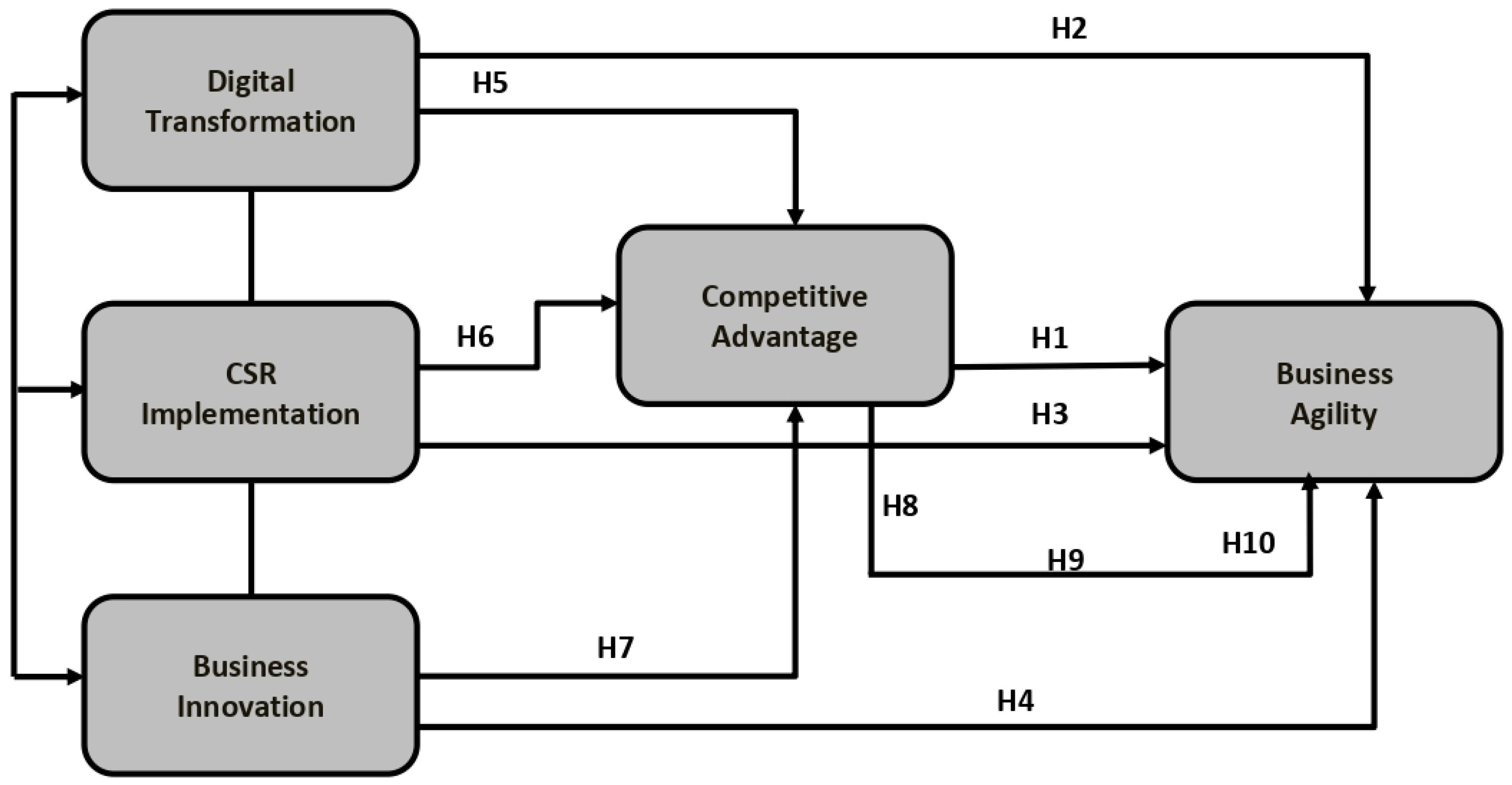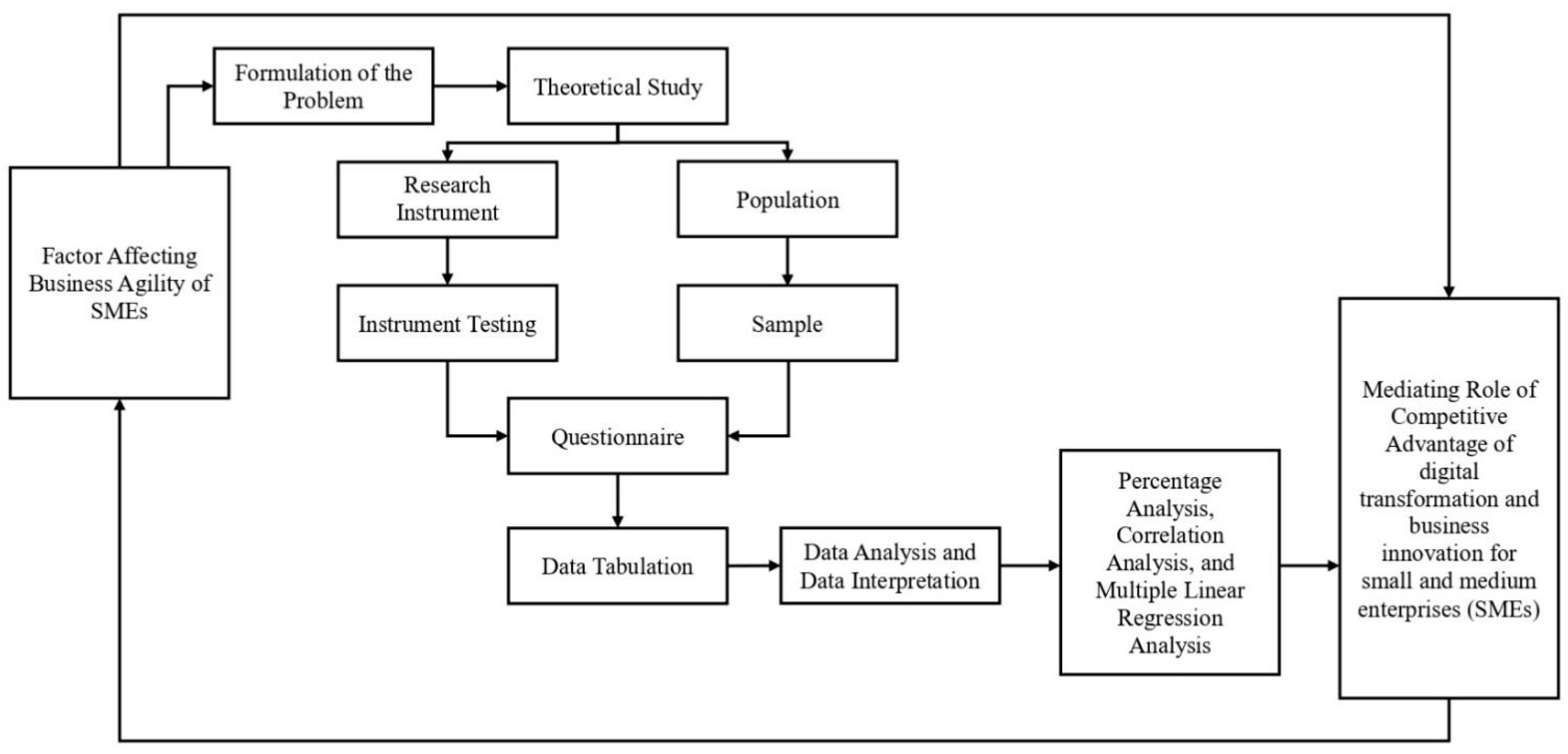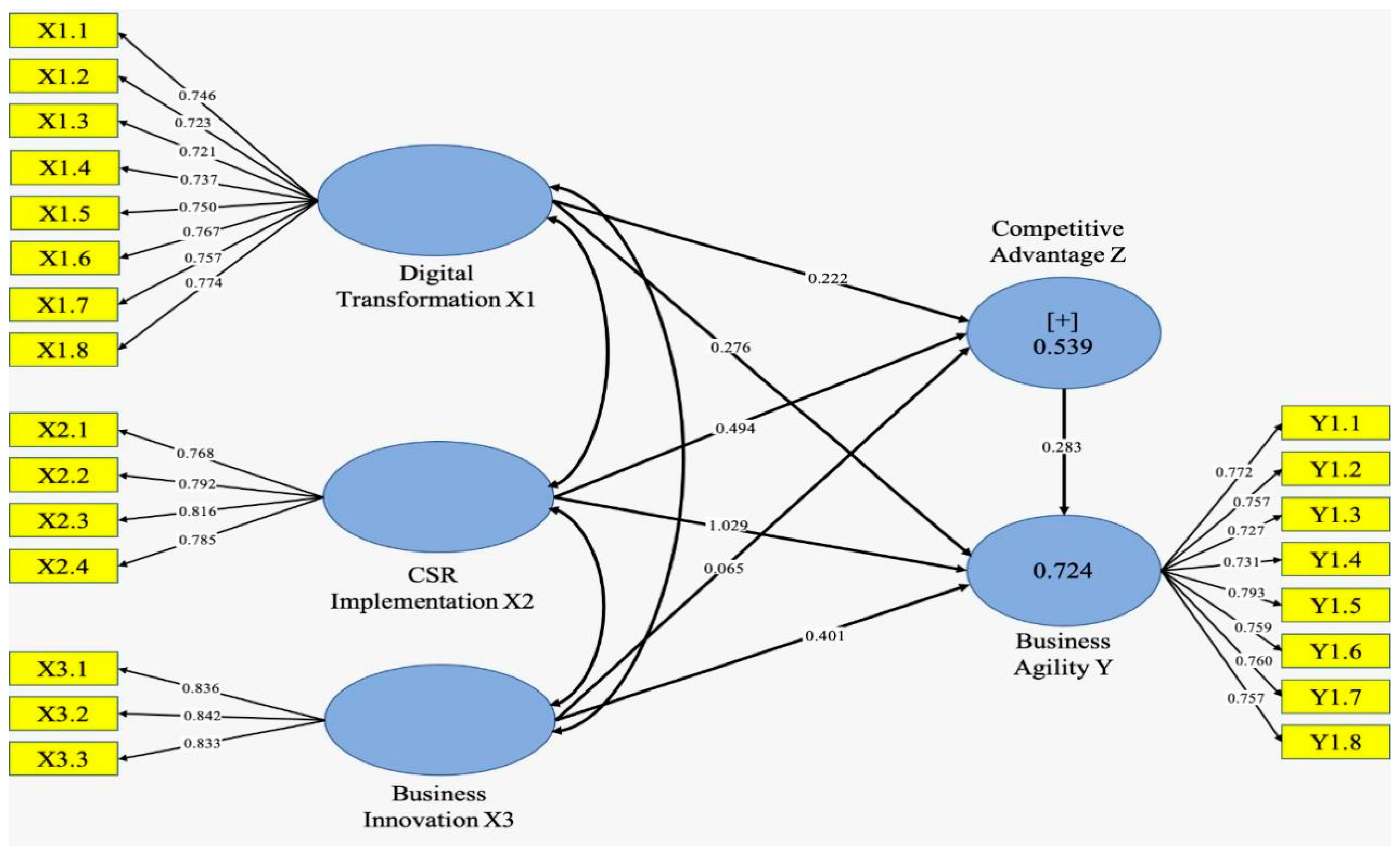2.1. Business Agility
Business agility can be understood as an organization’s capacity to adapt quickly to changing market dynamics, customer demands, and industry standards profitably and cost-effectively without compromising on quality. Business agility empowers SMEs to continuously stay on top of other markets. Business agility is characterized by the presence of human resources that are capable of providing solutions, business development, IT utilization, and the benefit of producing products and services faster than competitors.
The company’s agility can be seen from the ability to respond to market changes by creating applications that are easy to use and install by mobile users or prospective customers, so that the company can be more readily accepted, user-friendly, mobile, and agile. Innovation, differentiation, and speed of service are the driving forces to increase competitiveness and dominate market share. They also now have considerable onboarding in the marketplaces in Makassar. The marketplace has also helped and taught business actors to enter the digital realm. In addition, the government, academia, the business world, the media, and the community must jointly support the creation of new entrepreneurs and the development of SMEs to create excellent and competitive entrepreneurs.
Competitive advantage is the ability obtained through the characteristics and resources of an SME to have a higher performance than other SMEs in the same industry or market. A competitive advantage comes from the ability of SMEs to take advantage of their internal strengths to respond to external environmental opportunities by minimizing internal weaknesses [
32]. The competitive advantage comes from the many different activities carried out by SMEs in designing, producing, marketing, and distributing their products. Findings [
33] reveal that the development of a competitive advantage makes it easier for SMEs to achieve business agility. SMEs that can achieve and maintain differentiation will become high-performing SMEs in their industry. Research by [
34] found that higher innovation capacities were better able to leverage their digital platforms to increase agility. The development of a competitive advantage requires speed and flexibility, and does not only focus on the profitability of SMEs [
35]. A competitive advantage emphasizes high speed and flexibility as the main attributes in adapting to environmental turbulence. This principle is like the concept of innovation, which always tries to answer market demands by making changes [
36].
2.3. Corporate Social Responsibility Implementation (CSR)
Implementing corporate social responsibility (CSR) programs carried out by SMEs in Makassar City means commitment to being ethical and contributing to economic development while improving the quality of life of workers and their families, as well as that ofthe local community and surrounding communities. The following table presents CSR expenses in social programs by SMEs in Makassar City.
According to The World Business Council for Sustainable Development, CSR is an ongoing commitment of business people to behave ethically and to contribute to economic development while improving the quality of life for workers and their families, as well as that of the local community and surrounding communities [
48]. Based on the description above, in the concept of CSR, in addition to being economically responsible for SMEs in the form of profit to their shareholders, SMEs must also run their businesses according to applicable laws, and must apply ethics, morals, and charity (philanthropy) to the environment. The implementation of the CSR concept has the implication that SMEs must also have responsibilities to other parties, such as employees, suppliers, consumers, government, local community groups, and the wider community [
49].
CSR is a form of responsibility of business people for the negative and positive impacts of the production process. When a corporation fulfills its social and environmental duty, it will bring benefits to its existence. The CSR of SMEs can be seen as an action taken by SMEs as a sense of responsibility towards the community and the surrounding environment. The responsibility can be in the form of improving the prosperity of the community, protecting the environment, and building public facilities. A well-implemented CSR implementation could increase public confidence in the presence of SMEs. CSR can be used as a competitive tool for SMEs, which can later help pave the way for obtaining the resources needed by those SMEs [
50].
The findings of [
51] from 205 SMEs in manufacturing and consumer products in Iran revealed that CSR has a positive influence on the performance of SMEs, due to the positive effect of CSR on competitive advantage, reputation, and customer satisfaction. Similar results also from [
52,
53,
54,
55] found that better CSR had a positive impact on competitive advantage. Findings from [
56,
57,
58,
59] revealed that CSR activities can create a sustainable competitive advantage in terms of increasing customer loyalty, which then facilitates SMEs in creating business agility, business innovation and corporate image.
Innovation is one of the corporate choices when facing market competition and sustainable management. Ref. [
60] considers innovation as the efforts of SMEs through the use of technology and information to develop, produce, and market products that are new to the industry. It can be said that innovation is the modification or discovery of ideas for continuous improvement and development to meet customer needs. Ref. [
61] revealed that SME innovation can result in research and development (R and D) in terms of production and marketing approaches, which ultimately leads to product commercialization. In other words, innovation is the process of realizing a new idea, which is different from the previous one by means of production, or by making it a reality where innovation includes evaluation, the discovery of new concepts, and implementation. The innovation capacity of SMEs has a positive relationship with the business agility of SMEs. SMEs with higher innovation capacity are better able to leverage their digital platforms to increase agility [
34,
62].
Continuation of the acceptance of the concept of CSR within the framework of sustainable development, in addition to the impact caused by the company on the economy, social sphere, and environment must be reported by the company in a sustainability report or citizenship report, which is currently a mirror that describes the extent of corporate social responsibility towards their stakeholders. CSR implies that the company has a moral obligation to act honestly, comply with the law, uphold integrity, and not be corrupt. CSR emphasizes that companies must develop business practices that are ethical, as well as economically, socially, and environmentally sustainable. Considering that CSR is intangible, it is difficult to measure the level of success achieved, and bench marking is difficult. Organizations need to apply directed strategies, concepts, and applications with various approaches to make them quantitative by using the Triple Bottom Line or Sustainability Reporting approach.
The philosophy (substance existence principles) of CSR is that it strengthens the company’s ability to adapt to its environment, community, and stakeholders related to it, both local and national. The benefits of implementing CSR for strategic companies include increasing sales and market share, strengthening brand positioning, improving corporate image, lowering operating costs, and increasing the attractiveness of the company in the eyes of investors and financial analysis.
Meanwhile, the ESG (environment, social, and governance) criteria form a framework pillar that aims to identify all non-financial risks and opportunities related to corporate routines. What are the ESG in the company? This is the abbreviation for environmental, social, and governance factors. These three big factors are used to measure the sustainability and ethical impact of investment results in a business or company.
The framework provides principles-based guidance that helps identify ESG topics to determine how to organize and prepare the ESG information disclosed by companies. Governments around the world have issued non-binding guidelines to help companies present relevant non-financial information in a more consistent and comparable manner as follows: (a) Reporting standards provide specific and detailed information requirements that help companies or others using them determine which specific metrics or indicators will be required for each topic. In Europe, the standards most frequently used by companies in their ESG reporting are those issued by the Global Reporting Initiative (GRI). The GRI standards enable companies to report the impact of their social and environmental activities to stakeholders. This standard can be directly verified by interested parties. (b) The GRI standards enable any organization, large or small, private or public, to understand and report on the impact of their ESG performance on the economy, environment, and people in a comparable and credible manner, thereby increasing the transparency of their contribution to sustainable development. Apart from companies, this standard is highly relevant to many stakeholders, including investors, policy makers, capital markets, and civil society. The standards used by the GRI are designed to be easy-to-use, modular tools that provide an inclusive overview of an organization’s material topics, their associated impacts, and how they are managed.
The image of SMEs is needed to influence customers through a combination of advertising, public relations, physical form, word of mouth, and various actual experiences while using goods and services. From those statements, customers consider the capabilities of SMEs to form their perceptions of what is offered and will have an impact on customer buying behavior. According to [
63], the image of an SME is the impression, feeling, or image of the community or the public towards the SME, which is an impression created from a product or service offered. The image of an SME is the public’s perception of the SME or their products [
64]. The SME image relates to the business name, architecture, variety of products, traditions, ideology, and the impression of quality that is communicated by every employee who interacts with the organization’s clients. Ref. [
65] stated that the good image of SMEs can arise from aspects that show their seriousness in the social responsibility of SMEs that are more concerned with environmental sustainability. Concerning the findings of [
66], the image of an SME will be more profitable when the SME is able to consistently display the quality and quantity of services that impress their audiences [
67]. A good image arises from the result of public evaluation or response to various activities, empathy, achievements, and reputation of an SME during their various activities. This can be achieved by integrating information technology, which currently makes it easier for customers to get the products they want [
68]. For greater clarity, the scope of the research, along with all the hypotheses, are illustrated as shown in
Figure 1.
In reference to the theory that is used as the basis of this study, the hypotheses built in this study are as follows:
Hypothesis 1 (H1). Competitive advantage affects the business agility of SMEs in Makassar City, Indonesia.
Hypothesis 2 (H2). Digital transformation affects the business agility of SMEs in Makassar City, Indonesia.
Hypothesis 3 (H3). CSR implementation affects the business agility of SMEs in Makassar City, Indonesia.
Hypothesis 4 (H4). Business innovation affects the business agility of SMEs in Makassar City, Indonesia.
Hypothesis 5 (H5). Digital transformation affects the competitive advantage of SMEs in Makassar City, Indonesia.
Hypothesis 6 (H6). CSR implementation affects the competitive advantage of SMEs in Makassar City, Indonesia.
Hypothesis 7 (H7). Business innovation affects the competitive advantage of SMEs in Makassar City, Indonesia.
Hypothesis 8 (H8). Competitive advantage is able to mediate the relationship of Digital transformation to business agility.
Hypothesis 9 (H9). Competitive advantage is able to mediate the relationship of CSR implementation to business agility.
Hypothesis 10 (H10). Competitive advantage is able to mediate the relationship of Business innovation to business agility.








